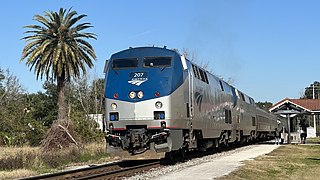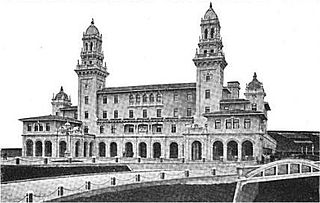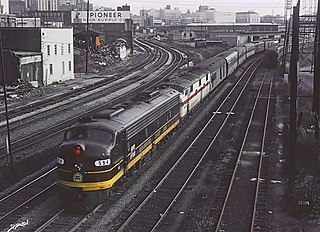
The Seaboard Air Line Railroad, which styled itself as "The Route of Courteous Service", was an American railroad that existed from April 14, 1900, until July 1, 1967, when it merged with the Atlantic Coast Line Railroad, its longtime rival, to form the Seaboard Coast Line Railroad. Predecessor railroads dated from the 1830s and reorganized extensively to rebuild after the American Civil War. The company was headquartered in Norfolk, Virginia, until 1958, when its main offices were relocated to Richmond, Virginia. The Seaboard Air Line Railway Building in Norfolk's historic Freemason District still stands and has been converted into apartments.

The Atlantic Coast Line Railroad was a United States Class I railroad formed in 1900, though predecessor railroads had used the ACL brand since 1871. In 1967, it merged with long-time rival Seaboard Air Line Railroad to form the Seaboard Coast Line Railroad. Much of the original ACL network has been part of CSX Transportation since 1986.

The Louisville and Nashville Railroad, commonly called the L&N, was a Class I railroad that operated freight and passenger services in the southeast United States.

The Silver Meteor is a long-distance passenger train operated by Amtrak between New York City and Miami, Florida. Introduced in 1939 as the first diesel-powered streamliner between New York and Florida, it was the flagship train of the Seaboard Air Line Railroad (SAL) and one of the flagship trains of its successor, the Seaboard Coast Line Railroad (SCL). The train was transferred to Amtrak when it took over intercity passenger rail service in 1971.

The Silver Star is a long-distance passenger train operated by Amtrak on a 1,522-mile (2,449 km) route between New York City and Miami via Washington, D.C., Richmond, Virginia, Raleigh, North Carolina, Columbia, South Carolina, Savannah, Georgia, Jacksonville, Florida, and Tampa, Florida. The Silver Star and its sister train in the Silver Service brand, the Silver Meteor, are the descendants of numerous long-distance trains that operated between Florida and New York for most of the 20th century.

The Palmetto is a passenger train operated by Amtrak on a 829-mile (1,334 km) route between New York City and Savannah, Georgia, via the Northeast Corridor, Washington, D.C., Richmond, Virginia, Fayetteville, North Carolina, and Charleston, South Carolina. The Palmetto is a shorter version of the Silver Meteor, which continues south to Miami, Florida. From 1996 to 2002 this service was called the Silver Palm. Although currently a day train, the Palmetto is considered a long-distance train by Amtrak and previously provided overnight sleeper service to Florida.

Terminal Station was the larger of two principal train stations in downtown Atlanta, Union Station being the other. Opening in 1905, Terminal Station served Southern Railway, Seaboard Air Line, Central of Georgia, and the Atlanta and West Point. The architect was P. Thornton Marye, whose firm also designed the Fox Theater and Capital City Club in downtown Atlanta, as well as the Birmingham Terminal Station.

The Champion was a streamlined passenger train operated by the Atlantic Coast Line Railroad and Florida East Coast Railway between New York City and Miami or St. Petersburg, Florida. It operated from 1939 until 1979, continuing under the Seaboard Coast Line and Amtrak. It was a direct competitor to the Seaboard Air Line Railway's Silver Meteor, the first New York-Florida streamliner.
The South Wind was a named passenger train equipped and operated jointly by the Pennsylvania Railroad, the Louisville and Nashville Railroad, the Atlantic Coast Line Railroad, and the Florida East Coast Railway. The South Wind began operations in December 1940, providing streamliner service between Chicago, Illinois and Miami, Florida. This was one of three new seven-car, all-coach streamliners operating in coordination every third day along different routes between Chicago and Miami. The other two longest enduring Chicago-Florida trains were the City of Miami and the Dixie Flagler. The South Wind remained in service through the creation of Amtrak in 1971.
The Gulf Wind was a streamlined passenger train inaugurated on July 31, 1949, as a joint operation by the Louisville and Nashville Railroad and the Seaboard Air Line Railroad. The Gulf Wind replaced the heavyweight New Orleans - Florida Express on this routing. The Gulf Wind was a limited stops train and offered amenities such as dining cars and Pullman service. The train left Jacksonville at night and arrived in New Orleans in the evening, as the Express had done.

The Silver Comet was a streamlined passenger train inaugurated on May 18, 1947, by the Seaboard Air Line Railroad. Before its inaugural run, the new train was christened by actress Jean Parker at Pennsylvania Station in New York City. The train succeeded the SAL's Cotton States Special, which took the same route and which like the Silver Comet left the northeast at midday and arrived at Birmingham in the late morning.

The City of Miami was a seven-car coach streamliner inaugurated by Illinois Central Railroad on December 18, 1940. Its route was from Chicago to Miami a total distance of 1,493 miles (2,403 km).
The Ponce de Leon was a named train of the Southern Railway which ran from Cincinnati, Ohio, to Jacksonville, Florida, from 1924 to the mid-1960s.

The Vacationer was a seasonal passenger train operated by Amtrak between New York City and Miami, Florida. The Vacationer, like its predecessor the Florida Special, was designed to supplement regular Northeast—Florida service during the winter months. It made its final run on March 31, 1974. The Florida Special dated back to 1888; the Vacationer originated in 1938.

The Dixie Flagler was a streamlined passenger train operated by the Florida East Coast Railway (FEC) between Chicago, Illinois and Miami, Florida. It began in 1939 as the Henry M. Flagler, a regional service between Miami and Jacksonville, Florida; the FEC renamed it and extended it to Chicago a year later. It was one of the few Chicago to Florida trains that passed through Atlanta. As an overnight streamliner it was part of the every-third-day pool shared by the City of Miami and South Wind. It was renamed Dixieland in 1954 and discontinued altogether in 1957.

The Dixie Flyer was a premier named passenger train that operated from 1892 to 1965 via the "Dixie Route" from Chicago and St. Louis via Evansville, Nashville, and Atlanta to Florida. However, the train continued until 1969 as an Atlanta to Florida operation, run solely by the Atlantic Coast Line Railroad and its successor, the Seaboard Coast Line. The Flyer's route varied in early years, but by about 1920 was set as follows:

The Seminole, also known as the Seminole Limited, was a passenger train operated by the Illinois Central Railroad, Central of Georgia Railway, and Atlantic Coast Line Railroad between Chicago, Illinois and Jacksonville, Florida. It operated from 1909 to 1969 and was the first year-round service between the two cities.
The Flamingo was a passenger night train operated by the Louisville and Nashville Railroad.

The Kansas City–Florida Special was a pooled night train and the premier train of the Frisco Railroad and the Southern Railway. Operating from Kansas City, Missouri to Jacksonville, Florida, it was unique as being one of very few long distance passenger train to traverse the Mississippi River south of St. Louis, Missouri and north of New Orleans, Louisiana.
The Southland was a night train between Chicago, Illinois and different points in western and eastern Florida from 1915 to 1957. In the early years it was called the New Southland. It was distinctive among Midwest to Florida trains as its western branch was the only all-season mid-20th-century long-distance train passing from Georgia to Florida bypassing the usual passenger train hub of Jacksonville Union Station. The main operator was the Louisville and Nashville Railroad, and pooling partners were the Pennsylvania Railroad, the Atlantic Coast Line Railroad and to lesser extent, the Wabash Railroad and the Florida East Coast Railway. For southeast bound -but not northwest bound- trips to Norfolk, Virginia, some coaches in 1946 diverged at Cincinnati along a Norfolk and Western Railway route. Northwest bound, travelers could switch trains at Cincinnati for heading towards Chicago.


















